Discover the art of preparing succulent salmon with herb butter in this comprehensive guide. Whether you’re a seasoned chef or new to the kitchen, crafting a flavorful meal with fresh herbs and rich butter can elevate your dining experience to new heights. From selecting the perfect herbs to mastering the technique, this article explores everything you need to know to create a mouthwatering dish. Learn how to enhance your salmon with a variety of herbs, explore different cooking methods, and even gain insights from culinary experts. With tips on creating the best herb butter, choosing the right cooking oil, and incorporating flavors that complement salmon perfectly, this guide is your ultimate resource for creating a memorable meal. Dive in and unlock the secrets to making salmon with herb butter like a pro!
Herb Butter Salmon Recipe: A Delightful Meal
Ingredients:
– 4 salmon fillets (about 6 oz each)
– 4 tbsp unsalted butter
– 4 cloves garlic, minced
– 1 tsp lemon zest
– Salt and pepper to taste
– Fresh herbs (dill, parsley, chives) or ½ tsp dried herbs
– Lemon wedges for garnish
– Optional: Roasted vegetables (broccoli, potatoes)
Instructions:
- Preheat Oven: Begin by preheating your oven to 400°F (200°C).
- Prepare Baking Dish: Arrange salmon fillets in a single layer in a greased baking dish.
- Butter and Season: Drizzle each fillet with 1 tbsp of melted butter. Sprinkle minced garlic, lemon zest, salt, and pepper evenly over the fillets.
- Bake: Bake for 15-18 minutes until the salmon is cooked through and flakes easily with a fork.
- Add Herbs: After baking, scatter fresh herbs or sprinkle dried herbs over the fillets. Garnish with lemon wedges.
- Serve: Serve warm with sides of roasted vegetables, wild rice, or a crisp salad.
Tips:
– Doneness Check: Test with a fork; salmon should flake easily.
– Variety: Adjust butter quantity based on serving size. Use fresh herbs if available, otherwise, a pinch more dried herbs work well.
– Sides: Customize with quinoa or a simple green salad for a lighter meal.
Enjoy this rich, flavorful dish that balances perfectly with aromatic herbs and zesty lemon, creating a memorable dining experience!
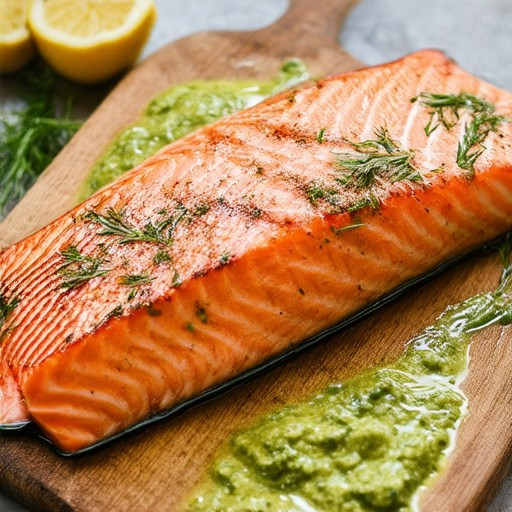
Which Herb Goes Best with Salmon?
The best herbs to pair with salmon can elevate your dishes, enhancing both flavor and presentation. Here’s a curated list of herbs that complement salmon perfectly:
- Dill : A classic choice, dill pairs wonderfully with smoked or grilled salmon, offering a refreshing flavor.
- Parsley : Fresh parsley adds a bright, herby note to dishes like grilled salmon or salmon pasta.
- Basil : Basil’s sweet, peppery taste balances the richness of salmon, ideal for Caprese-style salads or tomato-based dishes.
- Tarragon : Known for its delicate anise flavor, tarragon elevates dishes like béchamel sauces or marinades for a sophisticated touch.
- Sage : Sage’s earthy aroma adds depth to dishes like stuffed salmon or creamy sauces, enhancing the fish’s natural flavor.
- Rosemary : Rosemary’s pine-like aroma complements grilled salmon, especially when paired with garlic and lemon.
- Bay Leaves : These small, potent leaves add complexity to soups, stews, and braised dishes, enriching the broth.
- Thyme : Thyme’s subtle mintiness freshens dishes, making it a great addition to marinades or grilled salmon.
- Cilantro : Cilantro’s citrusy notes brighten up ceviche, sushi, and cooked salmon, offering a refreshing finish.
- Fennel : Fennel’s licorice-like flavor, when used in moderation, adds a unique twist to dishes like salmon patties or salads.
For more creative ideas and recipes featuring these herbs, visit our herb guide dedicated to enhancing your seafood dishes.
How to Make Herb Butter
Follow these simple steps to create a flavorful herb butter that enhances your favorite dishes:
- Ingredients:
- 8 tbsp unsalted butter, softened
- 1/4 cup chopped fresh herbs (e.g., parsley, chives, rosemary)
- 1-2 cloves minced garlic (optional)
- 1 tsp lemon zest (optional)
- Salt and pepper to taste
- Instructions:
- In a large mixing bowl, beat the softened butter until creamy.
- Add the chopped herbs, minced garlic, lemon zest (if using), salt, and pepper. Mix well until smooth.
- Transfer the mixture to a small container or shape it into a log for easier storage.
- Refrigerate for at least 30 minutes to allow the flavors to meld.
Optional Additions:
You can customize your herb butter by adding:
- Cheese for a creamy texture
- Nuts or seeds for added crunch
- Dried herbs or spices like cayenne or paprika
Usage Tips:
Herb butter is perfect for:
- Bread or crackers
- Sandwiches
- Grilled meats, poultry, or fish
- Vegetable dips
Storage:
Store your herb butter in an airtight container or wrapped in plastic wrap in the refrigerator for up to 2-3 weeks.
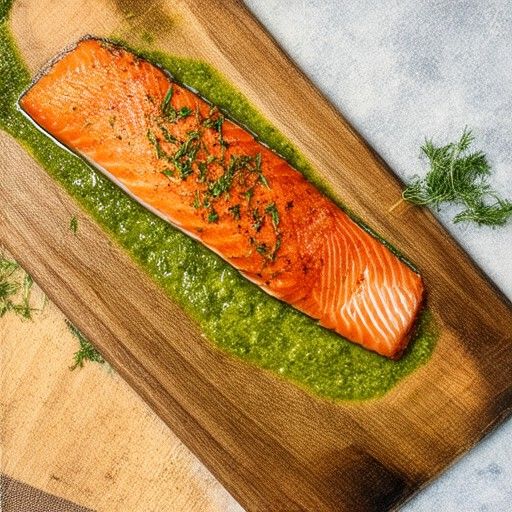
Gordon Ramsay’s Pan Seared Salmon Recipe
To prepare Gordon Ramsay’s pan seared salmon, follow these simple steps:
- Ingredients:
- 2 salmon fillets
- 1/4 tsp salt
- 1/8 tsp black pepper
- 1/8 tsp paprika
- 1 tbsp olive oil
- 1 tbsp butter
- 4 cloves of garlic
- 4 sprigs of thyme
- Instructions:
- Preparation: Let the salmon fillets come to room temperature. Pat them dry with paper towels, especially the skin side, to ensure a crispy texture.
- Seasoning: Generously sprinkle salt, pepper, and paprika on both sides of the salmon fillets. Make sure to season the skin side as well for flavor enhancement.
- Cooking Setup: Heat a large skillet over medium-high heat. Add olive oil and butter to the pan, allowing it to melt and slightly bubble before proceeding.
- Searing Process: Place the salmon fillets skin-side down in the pan. Cook for about 4-5 minutes, until the skin is crisp and golden brown. Flip the fillets and continue cooking for another 3-4 minutes on the other side, or until the internal temperature reaches 125°F (52°C), ensuring the flesh is still pink and cooked through.
- Garnishing: Sprinkle with chopped parsley or thyme leaves for added freshness and presentation. Serve immediately with your preferred sides, such as lemon wedges, roasted vegetables, or a creamy sauce.
For more detailed instructions and additional seafood recipes, visit our seafood recipe hub .
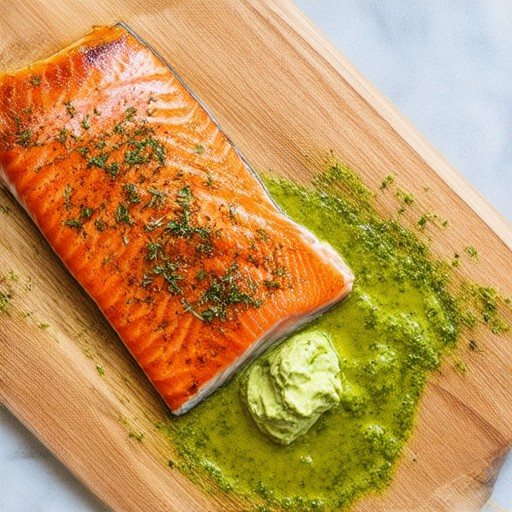
Is It Better to Use Oil or Butter for Cooking Salmon?
When deciding between oil and butter for cooking salmon, consider the following:
- Flavor Enhancement : Butter adds a rich, creamy flavor that enhances salmon’s natural taste, making it moister and more succulent. Oil, particularly vegetable oil, does not add flavor but prevents sticking and keeps the salmon tender.
- Health Considerations : Butter is high in saturated fats, which may not be ideal for those monitoring cholesterol or heart health. Oil, especially vegetable oil, is lower in saturated fats, offering a healthier alternative.
- Type of Oil : Olive oil can add a nutty flavor, complementing salmon well. Vegetable oil provides a neutral base, suitable for those preferring less flavor influence.
- Cooking Methods : In pan-frying, butter can be used initially for flavor, followed by oil to finish cooking. Grilling often uses oil to prevent sticking, while sautéing benefits from butter’s flavor enhancement.
Ultimately, the choice depends on your preference for flavor and dietary needs. Using a combination of butter and oil can offer the best of both worlds, ensuring a delicious and moist result.
What is the Tastiest Way to Cook Salmon?
Salmon is a versatile and delicious fish that can be cooked in various ways to suit different tastes and preferences. Whether you prefer a smoky grill flavor, a juicy bake, or a crispy sear, there’s a method for everyone. Here are some of the most popular and tasty cooking techniques:
Grilled Salmon
- Ingredients: Fresh salmon fillets, olive oil, lemon slices, herbs (dill, parsley), and your favorite BBQ sauce.
- Method: Preheat your grill to medium heat. Lightly brush the salmon with olive oil and season with salt and pepper. Place skin-side down on the grill and cook for 4-5 minutes. Flip and cook for another 3-4 minutes until it reaches your desired doneness. Brush with lemon juice and sprinkle with herbs before serving.
- Tip: For extra flavor, baste the salmon with a mixture of honey and soy sauce during cooking.
Baked Salmon
- Ingredients: Salmon fillets, butter, garlic, lemon zest, and fresh herbs.
- Method: Preheat your oven to 400°F (200°C). Arrange salmon in a baking dish, drizzle with butter, and scatter garlic cloves around. Sprinkle with lemon zest, salt, and pepper. Bake for 15-20 minutes until the salmon is cooked through and flakes easily with a fork.
- Tip: Add a side of roasted vegetables like broccoli and potatoes for a complete meal.
Pan-Seared Salmon
- Ingredients: Salmon fillets, olive oil, butter, shallots, and white wine (optional).
- Method: Heat a heavy skillet over medium-high heat. Add olive oil and butter. Season the salmon with salt and pepper. Place the fillets skin-side down in the pan and sear for 4-5 minutes. Flip and cook for another 2-3 minutes. Add shallots to the pan and deglaze with white wine, stirring to create a sauce. Reduce the heat and simmer until the wine is reduced by half. Serve with the pan juices drizzled over the salmon.
- Tip: For a richer taste, consider adding capers or dill to the sauce.
Seasoning and Serving Tips
- For a citrus twist, try seasoning with lemon pepper and serving over a bed of arugula salad.
- Pair baked salmon with a side of wild rice and steamed vegetables for a nutritious meal.
- Grilled salmon makes for a perfect summer dinner, paired with a cold beer or a refreshing ceviche salad.
These methods offer a variety of textures and flavors, ensuring you get the most out of your salmon. Whether you’re hosting a barbecue, preparing a romantic dinner, or just cooking for yourself, these techniques will elevate your salmon dishes to something extraordinary. For more seafood-inspired recipes and cooking tips, visit Only Fish Recipes .
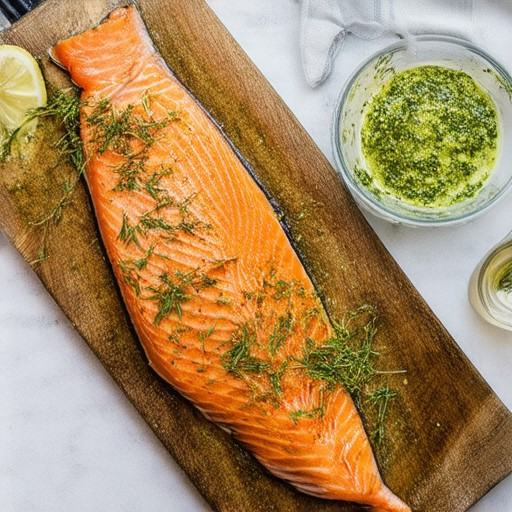
Is It Better to Pan Fry or Oven Cook Salmon?
To determine the better cooking method for salmon, let’s compare pan frying and oven cooking based on taste, ease, and cleanup:
Pan Frying Pros:
- Taste: Creates a crispy, flavorful crust due to direct oil interaction.
- Texture: Offers a firmer, more resistant mouthfeel.
- Cooking Control: Allows for precise searing and browning.
Oven Cooking Pros:
- Taste: Preserves moisture and natural salmon flavor.
- Ease: Requires minimal attention and cleanup.
- Healthier Option: Lower risk of acrylamide formation compared to high-heat pan frying.
Considerations:
- Equipment: Pan frying needs a non-stick pan, while oven cooking is accessible with basic tools.
- Cleanliness: Oven cooking may be less messy with foil wrapping.
- Timing: Pan frying is quicker, while oven cooking allows for slower, even cooking.
Combined Method Recommendation:
For the best of both worlds, try searing the salmon in a pan first for a crispy exterior, then finish it in the oven to lock in moisture and tenderness. This hybrid approach ensures a delicious, well-textured result every time.
Conclusion:
Both methods have their merits, but the choice depends on your preferences for texture, taste, and convenience. Experiment with both to find what works best for your kitchen setup!

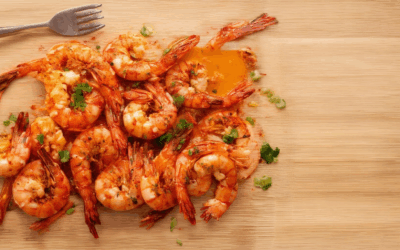
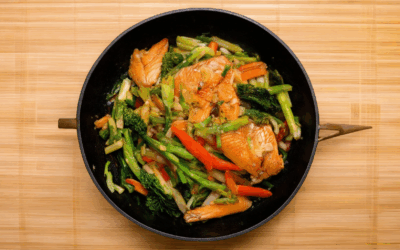
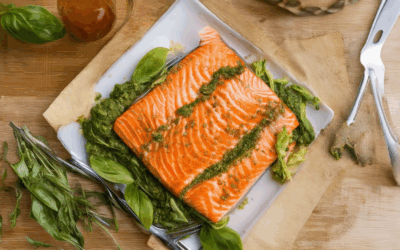
0 Comments